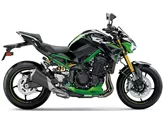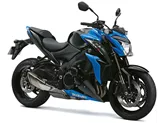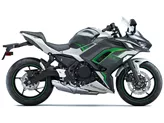Kawasaki Z1000 2014 vs. Kawasaki Z900 2017

Kawasaki Z1000 2014

Kawasaki Z900 2017
Overview - Kawasaki Z1000 2014 vs Kawasaki Z900 2017
The Kawasaki Z1000 model year 2014 and the Kawasaki Z900 model year 2017 are both naked bikes with similar engine types, in-line 4-cylinder engines. However, there are several differences between the two models in terms of specifications and performance.
In terms of engine power, the Kawasaki Z1000 2014 has a higher output with 142 HP compared to the Kawasaki Z900 2017 which has 125.4 HP. This means that the Z1000 may have a slight advantage in terms of acceleration and top speed. However, the Z900 compensates for this with its perfectly dimensioned torque of 98.6 Nm, which allows for excellent responsiveness and revving up willingly.
Both bikes have liquid cooling systems, ensuring optimal engine temperature regulation. The Z1000 has a displacement of 1043 ccm, while the Z900 has a slightly smaller displacement of 948 ccm. This difference in displacement may result in a slight variation in overall performance and fuel efficiency.

Kawasaki Z1000 2014
In terms of suspension, both bikes feature upside-down telescopic forks at the front. However, the Z1000 offers more adjustment options with compression, preload, and rebound adjustments, while the Z900 only has preload and rebound adjustments. This means that the Z1000 allows for more fine-tuning of the suspension to suit individual preferences and riding conditions.
The chassis of the Z1000 is made of aluminum, which provides a lightweight yet sturdy frame. On the other hand, the Z900 has a steel frame, which may add a bit more weight but also offers durability and stability.
Both bikes have double disk brakes at the front with four pistons. The Z1000 has radial technology and petal design, while the Z900 only has petal technology. This may result in slightly different braking performance, with the Z1000 potentially offering slightly better braking capabilities.
In terms of dimensions and weights, the Z1000 has a front tire width of 120 mm and a rear tire width of 190 mm, while the Z900 has a slightly narrower rear tire width of 180 mm. The wheelbase of the Z1000 is 1435 mm, slightly shorter than the Z900's 1450 mm. Additionally, the seat height of the Z1000 is 815 mm, while the Z900 has a slightly lower seat height of 795 mm.

Kawasaki Z900 2017
In terms of strengths, the Z1000 is praised for its sophisticated design, pleasant handling, pleasant sound, and good brakes. On the other hand, the Z900 is commended for its ingenious naked bike chassis, superb looks, and the engine's fine response and perfectly dimensioned torque. It is also noted that the Z900 offers an optimum intersection of performance, price, and practical use.
However, the Z1000 is criticized for its high purchase price compared to other models such as the S1000R. The Z900, on the other hand, is noted to have a narrow knee angle, which may be uncomfortable for tall riders. It is suggested that tall riders may need to order another seat to address this issue.
Overall, both the Kawasaki Z1000 2014 and the Kawasaki Z900 2017 are impressive naked bikes with their own unique strengths and weaknesses. The Z1000 offers a higher engine power and more suspension adjustment options, while the Z900 excels in its chassis design and engine performance. Ultimately, the choice between the two models will depend on individual preferences and priorities.
Technical Specifications Kawasaki Z1000 2014 compared to Kawasaki Z900 2017
Pros and Cons in comparison
Pros and Cons in comparison
Kawasaki Z1000 2014

The Kawasaki Z1000 (2014) is a statement against the electronic trend of its time - and that is exactly what makes it special today. Its characterful four-cylinder engine, mechanical directness and uncompromising focus on the essentials strike a chord in a time when many bikes have become rolling computers. Yes, it does without modern Advanced Rider Assistance Systems and perfect wind protection. But it offers an authentic naked bike riding experience, paired with Japanese reliability and reasonable maintenance costs. The Z1000 is not a bike for data sheet junkies or electronics fans - it is a bike for people who still want to make their own decisions when rider. An honest bike with character that continues to inspire even after years and more than fulfils its role as an emotional alternative to the digital modern age.
Kawasaki Z900 2017

An incredibly well-designed motorbike. A lot of test work and attention to detail went into it. It has exactly the right power, exactly the right chassis and exactly the right look. An all-round successful naked bike that will make you happy for a long time. If you like, you can ride it simply and faithfully, but if you want, you can also ride it really fast and it wheels like hell. Great!
Price Comparison Avarage Market Price Kawasaki Z1000 vs Kawasaki Z900
There are a few key differences between a Kawasaki Z1000 2014 and a Kawasaki Z900 2017. In terms of price, the actual average price of a Kawasaki Z1000 2014 is about 3% higher. A Kawasaki Z1000 2014 experiences a loss of 660 GBP in one year and 490 GBP in two years of ownership. This is offset by a loss of 530 GBP and 930 GBP for a Kawasaki Z900 2017. Compared to Kawasaki Z900 2017 there are less Kawasaki Z1000 2014 bikes available on the 1000PS.de Marketplace, specifically 12 compared to 43. It takes less time to sell a Kawasaki Z1000 with 75 days compared to 85 days for a Kawasaki Z900. Since model year 2005 1000PS.de editors have written 41 reviews for the Kawasaki Z1000 and 46 reviews for the Kawasaki Z900 since model year 2017. The first review for the Kawasaki Z1000 was published on 02/09/2002 and now has more than 5,800 views. This compares to more than 93,200 views for the first review on Kawasaki Z900 published on 11/11/2016.

















